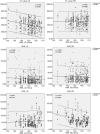Low dose contrast media in step-and-shoot coronary angiography with third-generation dual-source computed tomography: feasibility of using 30 mL of contrast media in patients with body surface area <1.7 m2
- PMID: 34079726
- PMCID: PMC8107323
- DOI: 10.21037/qims-20-500
Low dose contrast media in step-and-shoot coronary angiography with third-generation dual-source computed tomography: feasibility of using 30 mL of contrast media in patients with body surface area <1.7 m2
Abstract
Background: Reducing contrast media volume in coronary computed tomography angiography minimizes the risk of adverse events but may compromise diagnostic image quality. We aimed to evaluate coronary computed tomography angiography's diagnostic image quality while using 30 mL of contrast media in patients with a body surface area <1.7 m2.
Methods: This prospective study included patients who underwent coronary computed tomography angiography from May 2018 to June 2019. The patients were divided into a low-dose group, who received 30 mL of contrast media, and a routine-dose group, who received contrast media based on body weight. Patient characteristics, coronary computed tomography angiography results, and quantitative and qualitative image results were assessed and compared.
Results: In total, 103 patients with a body surface area <1.7 m2 were 53 in the low-dose group and 50 in the routine-dose group. Sex, age, body surface area, body weight, and heart rate were similar between the groups (P>0.05). A contrast media volume of 30±0 mL was used for the low-dose group, and 41.62±4.59 mL was used for the routine-dose group. The low-dose group's computed tomography values were significantly different from those of the routine-dose group (P<0.05). The radiologists demonstrated agreement regarding diagnostic image quality and accuracy (kappa =0.91 and 0.85, respectively).
Conclusions: Using 30 mL of contrast media for coronary computed tomography angiography in patients with a body surface area <1.7 m2 provided a suitable diagnostic image quality for coronary artery disease diagnosis. Although radiation doses were similar between the groups, the decreased contrast media volume was likely beneficial for the patients.
Keywords: Contrast media; body surface area; computed tomography angiography; coronary angiography; coronary artery disease.
2021 Quantitative Imaging in Medicine and Surgery. All rights reserved.
Conflict of interest statement
Conflicts of Interest: All authors have completed the ICMJE uniform disclosure form (available at http://dx.doi.org/10.21037/qims-20-500). The authors have no conflicts of interest to declare.
Figures




Comment in
-
Contrast agent volume in coronary computer tomography angiography-where are the limits?Quant Imaging Med Surg. 2021 Oct;11(10):4511-4513. doi: 10.21037/qims-21-488. Quant Imaging Med Surg. 2021. PMID: 34604006 Free PMC article. No abstract available.
References
-
- Leipsic J, Abbara S, Achenbach S, Cury R, Earls JP, Mancini GJ, Nieman K, Pontone G, Raff GL. SCCT guidelines for the interpretation and reporting of coronary CT angiography: a report of the Society of Cardiovascular Computed Tomography Guidelines Committee. J Cardiovasc Comput Tomogr 2014;8:342-58. 10.1016/j.jcct.2014.07.003 - DOI - PubMed
-
- Timal RJ, Kooiman J, Sijpkens YWJ, de Vries JPM, Verberk-Jonkers IJAM, Brulez HFH, van Buren M, van der Molen AJ, Cannegieter SC, Putter H, van den Hout WB, Jukema JW, Rabelink TJ, Huisman MV. Effect of no prehydration vs sodium bicarbonate prehydration prior to contrast-enhanced computed tomography in the prevention of postcontrast acute kidney injury in adults with chronic kidney disease: the Kompas randomized clinical trial. JAMA Intern Med 2020;180:533-541. 10.1001/jamainternmed.2019.7428 - DOI - PMC - PubMed
-
- Zhu X, Yu Y, Xu D, Zhang H, Tang L. Coronary angiography using second-generation dual source computed tomography: feasibility of low dose and low flow rate to achieve appropriate individual contrast enhancement using a test bolus-based contrast medium protocol-A CONSORT compliant article. Medicine (Baltimore) 2018;97:e11425. 10.1097/MD.0000000000011425 - DOI - PMC - PubMed
LinkOut - more resources
Full Text Sources
